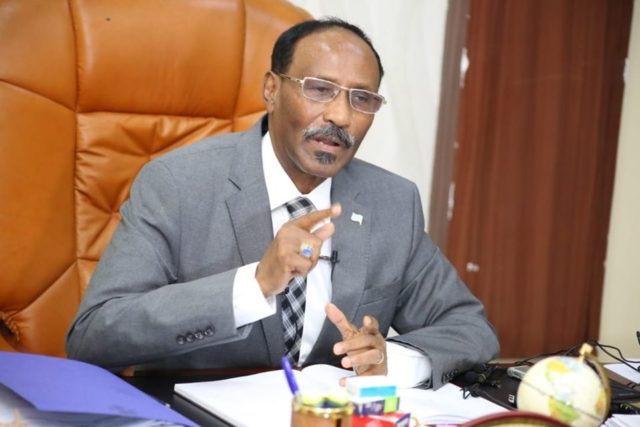MOGADISHU (HAN) April 25. 2021. Public Diplomacy and Regional Stability Initiatives News. Monitoring Regional Issues. Today Somalia’s Finance Minister Abdirahman Dualeh Beileh says all international donors have stopped budgetary support to Somalia. European Union, Saudi Arabia, United Sates, Qatar, another major donors, have also recently ended support. Situation for the Somali government is dire. The EU ended its budgetary support over human rights issues & election stalemate.
Min Beyle explained that the Federal Government of Somalia spends about $30 million (USD) monthly on government salaries, and international donors provided over 50% of that budget.
Min Beyle highlighted the progress Somalia has made to financial recovery, including obtaining relief for the nearly $5.3 billion in external debt.
The Somali government is heavily reliant on international aid and received US$ 1.9 billion in official development assistance in 2019 that was almost equal parts humanitarian (US$ 934 million) and development aid (US$ 924 million).
The World Bank, United Kingdom, European Union and Germany were the most significant contributors to development aid in 2019, providing more than 50% of total development aid (approximately US$ 500 million). The United States provided nearly half of all humanitarian assistance in 2019 (US$ 455 million).
The Somali diaspora is a significant contributor to Somalia. Their $1.3 billion in annual remittances sent to family and loved ones is between 25-40% of the entire economy.
The United States is the largest donor of humanitarian assistance in Somalia. The assistance will address life-threatening hunger and acute malnutrition and provide safe water, emergency health care, education, and protection to people affected by ongoing conflict and recurrent drought inside Somalia, and to Somali refugees in neighboring countries. Somalia recently experienced its worst harvest in 25 years, and up to 2.1 million people there could face life-threatening hunger by December of this year, according to the latest estimates. Additionally, approximately 2.6 million people – or one in five Somalis – are internally displaced, while more than 730,000 are seeking refuge in neighboring countries.
Rejecting foreign interference in domestic affairs (delayed #elections) is not so easy for #Somalia. In 2020, #donors provided 58% of gov. #revenue:
▶️@WorldBank $160m (32% of total gov. revenue)
▶️#EU $58.3m (12%)
▶️@AfDB_Group $27.7m (5.5%)
▶️#Turkey $15m (3%)
▶️@UN $5m (1%) pic.twitter.com/ZfzgRqtsVo— Patrick Heinisch (@PatrickHeinisc1) April 23, 2021
With regard to humanitarian assistance and foreign aid, the US has been one of Somalia’s biggest donors, making important contributions particularly in response to the major famines and droughts that have afflicted Somalia on a regular basis . Assistance for humanitarian relief and good governance has represented the majority of US aid disbursements to Somalia since 2006, although since 2015 smaller amounts have been disbursed as part of USAID’s transition initiatives for stabilization. US humanitarian initiatives have been complicated by domestic counterterrorism legislation that makes it difficult to provide assistance across substantial parts of south-central Somalia – where there is deemed to be a risk that such aid might benefit al-Shabaab. In 2010, however, with a major famine looming, the humanitarian advocacy community persuaded the US and the UN to grant an exception for humanitarian action under the Somalia sanctions regime. This meant that relief was able to flow to all areas in need of assistance, including those under al-Shabaab control.
On the military track, several hundred US troops are now regularly deployed in Somalia. They operate out of several commands, including AFRICOM, US Army Africa, the Combined Joint Task Force-Horn of Africa, Joint Special Operations Command, as well as a Military Coordination Cell based in Mogadishu since at least 2014. In 2016 the Obama administration moved to expand US military action in Somalia. The primary objective was to defend US, AU and some Somali security personnel in parts of Somalia that were not officially considered ‘areas of active hostilities’. The Trump administration went a step further in March 2017, designating parts of Somalia an ‘area of active hostilities’, which gave US military commanders greater leeway in defining targets and approving airstrikes. Under these expanded authorities, US troops have continued several longer-standing activities.
The U.S. Government remains concerned about the ongoing crisis in Somalia and the lack of sufficient humanitarian funds to address it. Large-scale assistance is urgent to prevent conditions in Somalia from worsening. The United States encourages other donors to increase their contributions to address Somalia’s critical humanitarian needs, and to help the most-vulnerable Somalis build resilience to withstand future shocks. The United Nations estimates that an additional $500 million in humanitarian funding is needed in Somalia through December 2019.


Leave a Reply